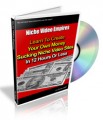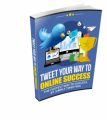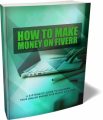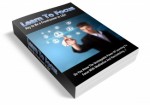Salespage Snapshot:

>>> Click Here To View Full Sales Page…
Table of Contents
Legal Notice ……….. 2
Table Of Contents .. 3
Killer Copy Secrets . 6
Introduction ……….. 7
Chapter 1: Headlines ………… 8
How To Write Attention Grabbing Headlines That Convert …….. 9
Your Headline Should Be Unique 9
Your Headline Should Be Ultra Specific …. 10
Your Headline Should Conveys A Sense Of Urgency ………….. 11
Your Headline Should Be Useful 12
Chapter 2: Writing To Communicate . 13
Tips For Writing Clear Copy ……….. 13
Put the Reader First …. 13
Carefully Organize Your Selling Points ….. 13
Break the Writing into Short Sections …… 14
Use Short Sentences … 15
Use Simple Words ……. 16
Be Concise …. 16
Be Specific …. 17
Chapter 3: Secrets For Powerful Copy ………….. 18
Make People Feel Like They Belong …………. 18
Ask People To Join …… 19
Create A Community .. 20
Display Client/ Customer Logos . 20
Show Off Social Media Number 21
Create A Feeling Of Exclusivity …… 22
Prove The Value Of Your Product .. 23
Establish Yourself As An Authority 25
Highly Trained Staff …. 25
Experienced Staff Members …… 26
Company History …….. 27
Provide “Reasons Why” .. 28
Chapter 4: Techniques For Profitable Advertising Ideas . 30
Identify the Problem ……. 30
Assemble Pertinent Facts ………….. 30
Gather General Knowledge ……….. 31
Look for Combinations … 32
Sleep on It …….. 32
Use a Checklist . 33
Get Feedback … 33
Team Up ……….. 34
Give New Ideas a Chance ………….. 35
Chapter 5: How To Close Deal With Your Copy 36
Call To Action … 36
Creating A Sense Of Urgency ……… 37
Make A Compelling Offer ………….. 39
Don’t Forget A Guarantee …………. 41
Outro ….. 42
Sample Content Preview
In addition to being unique, your headline should be ultra-specific. It should provide enough information to let customers know whether or not the offer you’re presenting is interesting to them. If your headline isn’t specific enough, customers won’t know whether or not what you’re selling is something they’re interested in.
Here’s an example:
A while ago I visited a blog with this headline: “You’ll Be Missed.” I had no idea what it was about. Did the owner lose a family member? Did her dog pass away? Did something else terrible happen? I felt bad for her, but I had no idea what was going on.
When I clicked through, I found out it was a post about Steve Jobs. He had just passed away in the past couple of days, and the author was writing about how she would miss Mr. Jobs. It ended up being a well-written post, but as a reader, I had no idea what it was about until I clicked through to read.
In cases like this, it’s much better to provide enough specific information to compel readers to continue reading than to write something “clever” that doesn’t give readers adequate information to decide whether or not they’re interested.
Your Headline Should Conveys A Sense Of Urgency
When possible, your headline should convey a sense of urgency. It should include something that compels readers to continue reading so they don’t miss out. This isn’t a rule that can always be used, but when it can, it works really well.
Here’s an example:
This post ended up doing well on the KISSmetrics blog. It’s titled “Are You Losing Sales by Giving Customers Too Many Choices?” So why was it so successful?
One of the reasons is that it conveys a sense of urgency. When business owners read it, automatically they think, “Hmmm… maybe I am losing sales. I need to read this article to find out.” And then they click through to read. The urgency of losing sales compels them to read the post.
Whenever possible, it’s good to write headlines that convey a sense of urgency to convince people to continue reading.
Your Headline Should Be Useful
This may be the most important tip of all. If your headline isn’t useful and doesn’t convey a benefit, then it may not give people a reason to continue on past the headline. People want to know what benefit they’ll receive from reading what you’ve written.
This also happens to be one of the rules that companies break the most. They end up writing something clever because for some reason most people think that’s the point of writing a headline. In doing so they fail to communicate a benefit and fail to give readers a reason to continue reading. Eventually, they end up with disappointing sales because no one pays attention to their copy. That’s a mistake you don’t want to make.
Chapter 2: Writing To Communicate
In an article published in the Harvard Business Review, Charles K. Ramond described experiments designed to measure advertising effectiveness. The experiments showed, not surprisingly, that advertising is most effective when it is easy to understand. In other words, you sell more merchandise when you write clear copy. In theory, it sounds easy. Advertising deals, for the most part, with simple subjects—clothing, soda, beer, soap, records. But in practice, many advertisements don’t communicate as effectively as they could. So, how to communicate in a right way? Here’s some tips for you.
Tips For Writing Clear Copy
Put the Reader First
Think of the reader. Ask yourself: Will the reader understand what I have written? Does he know the special terminology I have used? Does my copy tell her something important or new or useful? If I were the reader, would this copy persuade me to buy the product?
One technique to help you write for the reader is to address the reader directly as “you” in the copy, just as I am writing to you in this book. Copywriters call this the “you-orientation.” Flip through a magazine, and you’ll see that 90 percent of the ads contain the word “you” in the body copy.
Carefully Organize Your Selling Points
When you write your copy, you must carefully organize the points you want to make. In an ad, you might have one primary sales message (“This car gets good mileage”) and several secondary messages (“roomy interior,” “low price,” “$500 rebate”). The headline states the main selling proposition, and the first few paragraphs expand on it. Secondary points are covered later in the body copy. If this copy is lengthy, each secondary point may get a separate heading or number. The organization of your selling points depends on their relative importance, the amount of information you give the reader, and the type of copy you are writing (letter, ad, commercial, or news story).
Before you create an ad or mailer, write down your sales points. Organize them in a logical, persuasive, clear fashion. And present them in this order when you write your copy.
Break the Writing into Short Sections
If the content of your ad can be organized as a series of sales points, you can cover each point in a separate section of copy. This isn’t necessary in short ads of 150 words or less. But as length increases, copy becomes more difficult to read. Breaking the text into several short sections makes it easier to read.
What’s the best way to divide the text into sections? If you have a series of sections where one point follows logically from the previous point, or where the sales points are listed in order of importance, use numbers. If there is no particular order of importance or logical sequence between the sales points, use graphic devices such as bullets, asterisks, or dashes to set off each new section. If you have a lot of copy under each section, use subheads.
Other Details- 1 Ebook (PDF), 42 Pages
- 12 Videos (AVI, MP4)
- 1 Salespage (HTML)
- 6 Ecovers (PNG)
- 9 Promotional Ad Materials (Emails, Banners)
- Affiliate Program, Legal, OP2.0
- Year Released/Circulated: 2017
- File Size: 139,605 KB
License Details:
[YES] Can sell and keep 100% of the sales
[YES] Can be bundled into another paid package and sell at a higher price than $7
[YES] Can be used as a bonus to another product you are selling for minimum $7
[YES] Can be sold in a minimum $7 Dime sale event
[YES] Can be added into a minimum $7/month PAID membership site
[YES] Can pass on the Master Resell Rights privilege to your customers
[NO] Can be given away for free
[NO] Contents of the product can be edited, modified or altered














